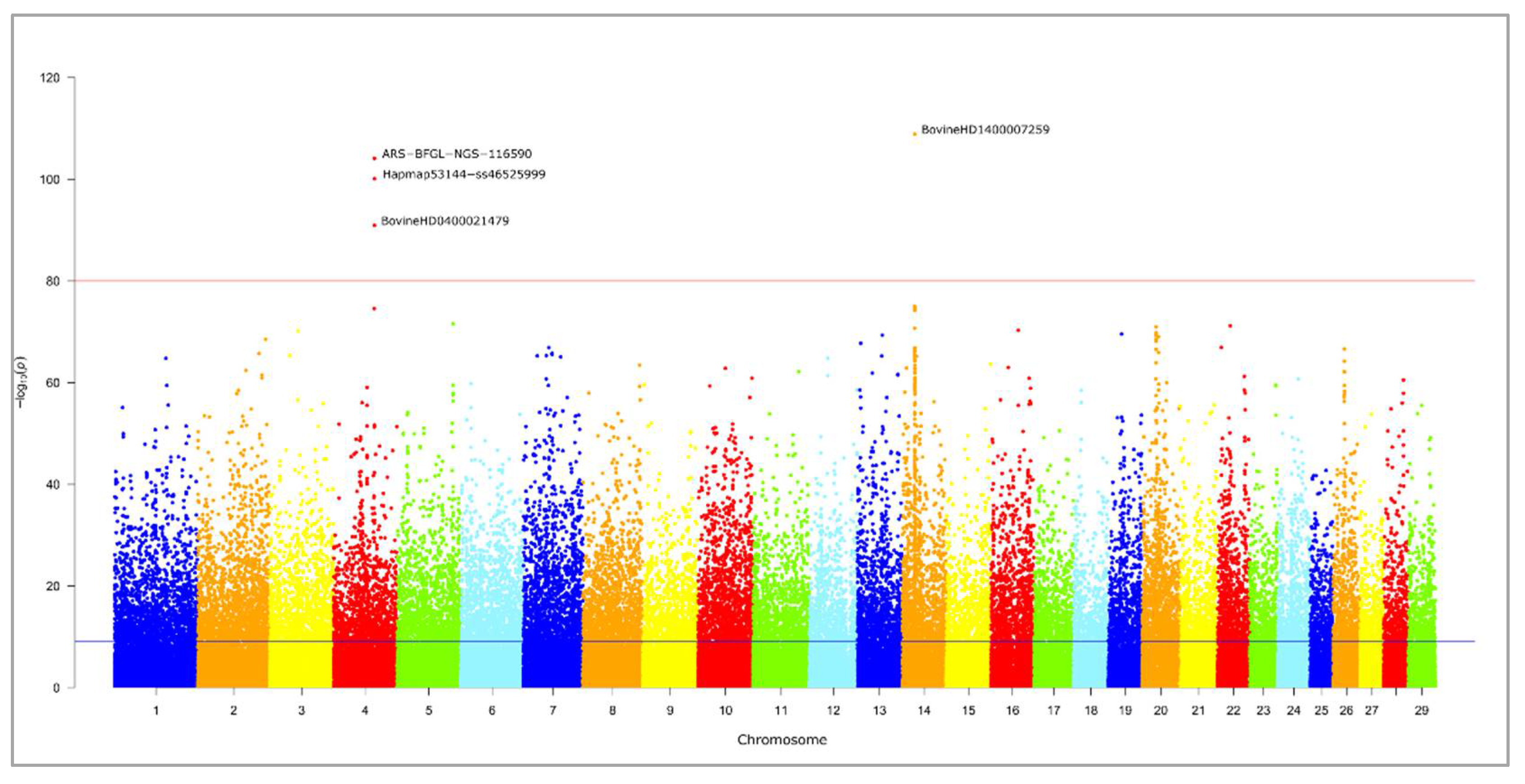Genome-Wide Screening for SNPs Associated with Stature in Diverse Cattle Breeds †
Abstract
:1. Introduction
2. Materials and Methods
3. Results and Discussion
4. Conclusions
Author Contributions
Funding
Institutional Review Board Statement
Informed Consent Statement
Data Availability Statement
Acknowledgments
Conflicts of Interest
References
- Bouwman, A.C.; Daetwyler, H.D.; Chamberlain, A.J.; Ponce, C.H.; Sargolzaei, M.; Schenkel, F.S.; Sahana, G.; Govignon-Gion, A.; Boitard, S.; Dolezal, M.; et al. Meta-analysis of genome-wide association studies for cattle stature identifies common genes that regulate body size in mammals. Nat. Genet. 2018, 50, 362–367. [Google Scholar] [CrossRef] [PubMed]
- Takasuga, A. PLAG1 and NCAPG-LCORL in livestock. Anim. Sci. J. 2016, 87, 159–167. [Google Scholar] [CrossRef] [PubMed] [Green Version]
- Randhawa, I.A.S.; Khatkar, M.S.; Thomson, P.C.; Raadsma, H.W. Composite selection signals for complex traits exemplified through bovine stature using multibreed cohorts of European and African Bos taurus. G3 Genes Genomes Genet. 2015, 5, 1391–1401. [Google Scholar] [CrossRef] [PubMed] [Green Version]
- Boitard, S.; Boussaha, M.; Capitan, A.; Rocha, D.; Servin, B. Uncovering adaptation from sequence data: Lessons from genome resequencing of four cattle breeds. Genetics 2016, 203, 433–450. [Google Scholar] [CrossRef] [PubMed] [Green Version]
- Hou, J.; Qu, K.; Jia, P.; Hanif, Q.; Zhang, J.; Chen, N.; Dang, R.; Chen, H.; Huang, B.; Lei, C. A SNP in PLAG1 is associated with body height trait in Chinese cattle. Anim. Genet. 2020, 51, 87–90. [Google Scholar] [CrossRef]
- Abdelmanova, A.S.; Kharzinova, V.R.; Volkova, V.V.; Mishina, A.I.; Dotsev, A.V.; Sermyagin, A.A.; Boronetskaya, O.I.; Petrikeeva, L.V.; Chinarov, R.Y.; Brem, G.; et al. Genetic diversity of historical and modern populations of russian cattle breeds revealed by microsatellite analysis. Genes 2020, 11, 940. [Google Scholar] [CrossRef] [PubMed]
- Abdelmanova, A.S.; Kharzinova, V.R.; Volkova, V.V.; Dotsev, A.V.; Sermyagin, A.A.; Chinarov, R.Y.; Zinovieva, N.A.; Boronetskaya, O.I.; Lutshikhina, E.M.; Sölkner, J.; et al. Comparative study of the genetic diversity of local steppe cattle breeds from Russia, Kazakhstan and Kyrgyzstan by microsatellite analysis of museum and modern samples. Diversity 2021, 13, 351. [Google Scholar] [CrossRef]
- Zinovieva, N.A.; Sermyagin, A.A.; Dotsev, A.V.; Boronetslaya, O.I.; Petrikeeva, L.V.; Abdelmanova, A.S.; Brem, G. Animal Genetic resources: Developing the research of allele pool of Russian cattle breeds—Minireview. Sel’skokhozyaistvennaya Biol. Agric. Biol. 2019, 54, 631–641. [Google Scholar] [CrossRef] [Green Version]
- Sermyagin, A.A.; Dotsev, A.V.; Gladyr, E.A.; Traspov, A.A.; Deniskova, T.E.; Kostyunina, O.V.; Reyer, H.; Wimmers, K.; Barbato, M.; Paronyan, I.A.; et al. Whole-genome SNP analysis elucidates the genetic structure of Russian cattle and its relationship with Eurasian taurine breeds. Genet. Sel. Evol. 2018, 50, 37. [Google Scholar] [CrossRef] [PubMed] [Green Version]
- Karim, L.; Takeda, H.; Lin, L.; Druet, T.; Arias, J.A.; Baurain, D.; Cambisano, N.; Davis, S.R.; Farnir, F.; Grisart, B.; et al. Variants modulating the expression of a chromosome domain encompassing PLAG1 influence bovine stature. Nat. Genet. 2011, 43, 405–413. [Google Scholar] [CrossRef] [PubMed]
- Doyle, J.L.; Berry, D.P.; Veerkamp, R.F.; Carthy, T.R.; Walsh, S.W.; Evans, R.D.; Purfield, D.C. Genomic regions associated with skeletal type traits in beef and dairy cattle are common to regions associated with carcass traits, feed intake and calving difficulty. Front. Genet. 2020, 11, 20. [Google Scholar] [CrossRef] [PubMed] [Green Version]
- Pryce, J.E.; Hayes, B.J.; Bolormaa, S.; Goddard, M.E. Polymorphic regions affecting human height also control stature in cattle. Genetics 2011, 187, 981–984. [Google Scholar] [CrossRef] [PubMed] [Green Version]


| Localization | SNP | Allele | Allele Frequencies | |
|---|---|---|---|---|
| High-Stature Breeds | Low-Stature Breeds | |||
| Chr 4 | ARS-BFGL-NGS-116590 | T | 0.204 | 0.349 |
| G a | 0.796 | 0.651 | ||
| p b | *** | *** | ||
| Hapmap53144-ss46525999 | T a | 0.795 | 0.082 | |
| C | 0.205 | 0.918 | ||
| p | *** | ** | ||
| BovineHD0400021479 | A | 0.201 | 0.309 | |
| G a | 0.799 | 0.647 | ||
| p | *** | *** | ||
| Chr 14 | BovineHD1400007259 | T | 0.090 | 0.959 |
| G a | 0.910 | 0.041 | ||
| p | *** | ns | ||
Publisher’s Note: MDPI stays neutral with regard to jurisdictional claims in published maps and institutional affiliations. |
© 2022 by the authors. Licensee MDPI, Basel, Switzerland. This article is an open access article distributed under the terms and conditions of the Creative Commons Attribution (CC BY) license (https://creativecommons.org/licenses/by/4.0/).
Share and Cite
Abdelmanova, A.S.; Sermyagin, A.A.; Dotsev, A.V.; Bardukov, N.V.; Fornara, M.S.; Brem, G.; Zinovieva, N.A. Genome-Wide Screening for SNPs Associated with Stature in Diverse Cattle Breeds. Biol. Life Sci. Forum 2022, 15, 24. https://doi.org/10.3390/IECD2022-12415
Abdelmanova AS, Sermyagin AA, Dotsev AV, Bardukov NV, Fornara MS, Brem G, Zinovieva NA. Genome-Wide Screening for SNPs Associated with Stature in Diverse Cattle Breeds. Biology and Life Sciences Forum. 2022; 15(1):24. https://doi.org/10.3390/IECD2022-12415
Chicago/Turabian StyleAbdelmanova, Alexandra S., Alexander A. Sermyagin, Arsen V. Dotsev, Nikolay V. Bardukov, Margaret S. Fornara, Gottfried Brem, and Natalia A. Zinovieva. 2022. "Genome-Wide Screening for SNPs Associated with Stature in Diverse Cattle Breeds" Biology and Life Sciences Forum 15, no. 1: 24. https://doi.org/10.3390/IECD2022-12415
APA StyleAbdelmanova, A. S., Sermyagin, A. A., Dotsev, A. V., Bardukov, N. V., Fornara, M. S., Brem, G., & Zinovieva, N. A. (2022). Genome-Wide Screening for SNPs Associated with Stature in Diverse Cattle Breeds. Biology and Life Sciences Forum, 15(1), 24. https://doi.org/10.3390/IECD2022-12415









